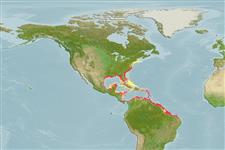Teleostei (teleosts) >
Eupercaria/misc (Various families in series Eupercaria) >
Sparidae (Porgies)
Etymology: Archosargus: Greek, archo = anus + Latin , sargus = sea bream (Ref. 45335).
More on author: Walbaum.
Environment: milieu / climate zone / depth range / distribution range
Ecology
Marine; brackish; reef-associated; depth range 15 - ? m (Ref. 9988). Subtropical; 49°N - 6°S, 100°W - 36°W (Ref. 55299)
Western Atlantic: Nova Scotia, Canada and northern Gulf of Mexico to Brazil. Absent in Bermuda, the Bahamas, the West Indies and Grenada (Ref. 7251, 26938).
Size / Weight / Age
Maturity: Lm ? range ? - ? cm
Max length : 91.0 cm TL male/unsexed; (Ref. 7251); common length : 35.0 cm TL male/unsexed; (Ref. 3815); max. published weight: 9.6 kg (Ref. 4699)
Inhabits bays and estuaries. Freely enters brackish waters; sometimes enters freshwaters (Ref. 26938). Commonly found around pilings. Caught by anglers from jetties or rocky shores (Ref. 9988). Feeds mainly on mollusks and crustaceans. An excellent food fish. Marketed fresh and frozen; eaten broiled, microwaved and baked (Ref. 9988).
Life cycle and mating behavior
Maturity | Reproduction | Spawning | Eggs | Fecundity | Larvae
Robins, C.R. and G.C. Ray, 1986. A field guide to Atlantic coast fishes of North America. Houghton Mifflin Company, Boston, U.S.A. 354 p. (Ref. 7251)
IUCN Red List Status (Ref. 130435: Version 2025-1)
Threat to humans
Harmless
Human uses
Fisheries: commercial; gamefish: yes; aquarium: public aquariums
Tools
Special reports
Download XML
Internet sources
Estimates based on models
Preferred temperature (Ref.
123201): 22.9 - 28, mean 25.9 °C (based on 192 cells).
Phylogenetic diversity index (Ref.
82804): PD
50 = 0.6250 [Uniqueness, from 0.5 = low to 2.0 = high].
Bayesian length-weight: a=0.02188 (0.01831 - 0.02614), b=2.98 (2.93 - 3.03), in cm total length, based on LWR estimates for this species (Ref.
93245).
Trophic level (Ref.
69278): 3.5 ±0.53 se; based on food items.
Resilience (Ref.
120179): Medium, minimum population doubling time 1.4 - 4.4 years (K=0.4; tmax=20).
Fishing Vulnerability (Ref.
59153): Moderate vulnerability (36 of 100).
🛈
Climate Vulnerability (Ref.
125649): High to very high vulnerability (69 of 100).
🛈
Nutrients (Ref.
124155): Calcium = 24.1 [9.8, 46.1] mg/100g; Iron = 0.562 [0.283, 1.069] mg/100g; Protein = 21 [20, 22] %; Omega3 = 0.215 [0.123, 0.398] g/100g; Selenium = 16.3 [7.4, 32.4] μg/100g; VitaminA = 22.3 [6.2, 82.3] μg/100g; Zinc = 0.703 [0.460, 1.099] mg/100g (wet weight);
